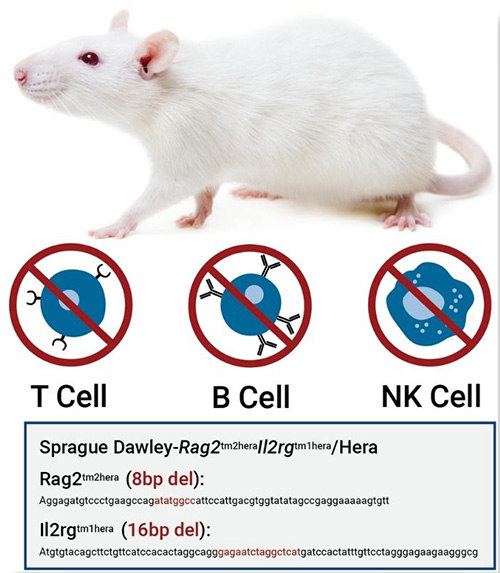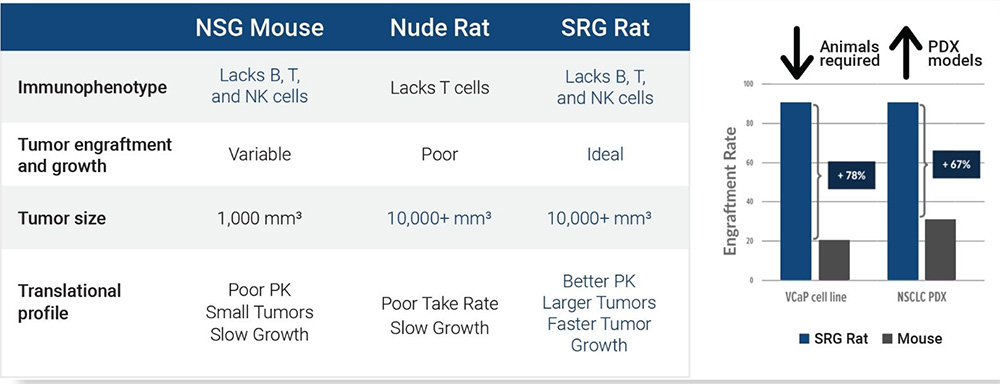Pre-clinical testing of oncology drugs can be costly and less effective due to low engraftment rates and small testing samples in mouse models. Now, oncology drug developers can benefit from multiple preclinical models, including a larger more robust Severe Combined Immunodeficient (SCID) rat. The SRG Rat (or “OncoRate”) model is aimed at setting an entirely new standard for translational research, delivering ~80-100% xenograft engraftment where tumors grow faster, more efficiently, and larger.
What’s Unique About the SRG Rat Model?
The SRG Rat was created through targeted knockout of the 112rg and Rag2 genes on the Sprague Dawley background. The Rag2 gene knockout leads to a defective V(D)J recombination preventing T cell and B cell development. The 112rg knockout results in a lack of cytokine signaling, resulting in defective lymphoid development.
The combined mutations result in a loss of mature B, T, and NK cells and the only severly immunodeficient rat model on the market. In comparison to the nude rat, which is only T-cell deficient, the SRG Rat is ideal for oncology and human immune system xenografts.

Validated Using Difficult Xenograft and Patient Derived Xenograft (PDX) Models
The SRG Rat has been validated with a wide range of xenograft tumor models (cell-lines and patient-derived) and consistently demonstrates high tumor take rates with traditionally difficult to engraft cell lines, such as VCaP and LNCap cells for prostate cancer, the H358 cell line for non-small cell lung cancer (NSCLC), HCC-1954 and MCF7 for breast cancer, and more. Subcutaneously implanted cell-line xenograft and PDX models can grow to at least 10,000 mm3 in volume compared to maximum volumes of 2,000 mm in mouse models of cancer.

Figure 1:UT-34 regresses the growth of (left) VCaP and (right) enzalutamide-resistant VCap tumors (MDVR) on SRG Rat xenografts.
How Does the SRG OncoRat Compare to Mouse Models?
Oncology research faces the challenge of identifying human-relevant models. Tumor xenografts and humanized immune systems are widely used to understand drug effects on human cancer tissues using in vivo models. The current standard has been models like the SCID or NOD scid gamma (NSG”) mouse.
However, mouse models can have limitations including low engraftment efficiencies, small tumors, slow growth, and variable tumor morphology.
Moreover, rats are typically used for toxicology, safety, and pharmacokinetics testing since the size, physiology, and cross-discipline data collection offer unique advantages for drug development. Therefore, efficacy studies using xenografts in rats may overcome many of the mouse limitations and serve as a complementary model. The SRG Rat demonstrates high efficiency and desirable uniformity in dozens of tumor growth profiles.

Accelerate Your Pre-Clinical Cancer Research and Drug Development
Research using SRG Rat offers our clients an economic, translational and ethical model. Our mission is to provide the best in vivo data utilizing the fewest number of animals. The SRG Rat engrafts human tumors at a higher rate with more uniform tumor kinetics, providing translational scientists with the tools they need for rapid decision making. Tumors can grow 10x larger in SRG Rats, facilitating more options for downstream analyses. Additionally, the ability to perform serial blood draws and serial tumor biopsies generates more data with fewer animals. Pharmacokinetics and toxicology testing can be combined, which means that fewer animals are necessary.
Hera Biolabs is offering innovative gene editing technology to researchers in academia and industry to make drug development more efficient. Hera also provides services in these areas, performing in vitro and in vivo oncology studies for clients featuring the SRG OncoRat.
